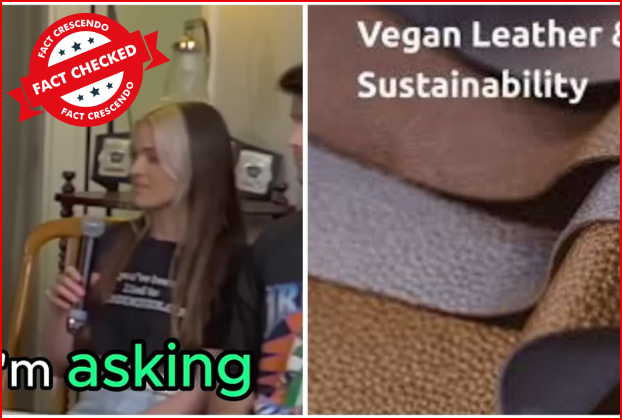Veganism, a lifestyle rooted in ethical concerns about animal exploitation, has gained widespread attention for its commitment to avoiding animal-derived products. Among the choices vegans make is opting for synthetic leather, often referred to as “vegan leather,” as a substitute for traditional animal leather. However, a recent dialogue between a vegan activist and a farmer has raised questions about the environmental impact of vegan leather, specifically regarding its carbon footprint. In this article, we embark on a fact-checking mission to determine whether vegan leather production emits as much carbon dioxide (CO2) as driving a significant distance.
Social Media Posts
A YouTube short video has been shared in which a farmer is shown making claims about the carbon footprint of synthetic leather against a female vegan activist. This YouTube video has garnered significant attention by claiming that veganism supports climate change and human-caused global warming due to carbon footprint. The dialogue is mentioned below.
‘Farmer – You are wearing a belt. Is that leather or artificial?
vegan activist – Yeah vegan leather.
Farmer – But it’s leather. A synthetic material.
vegan activist – Yes, it’s not someone’s skin. So, it’s an artificial product.
Farmer – Yes Vegan leather. It’s synthetic material you have got. That produces as much as CO2 for driving my car from here to Darwin.
vegan activist – Can I see the scientific results?
Farmer – You go to the WHO website of the United Nations. It produces much CO2. Let me show you that every 500 grams of synthetic material is created. It produces as much CO2 as driving 2000 km.’
We decided to do a fact-check on this.
Fact Check
Understanding Veganism
Before diving into the environmental aspect, it’s crucial to acknowledge that veganism is not solely a dietary choice but a comprehensive lifestyle to prevent animal exploitation. Vegans abstain from using any products or services derived from animals and advocate for animal rights.
The term “vegan” was coined in 1944 by members of the English Vegetarian Society, who recognized the ethical link between the meat, milk, and egg industries. They proposed that true ethical consistency required abstaining from all animal products.
Veganism has gained momentum as a response to environmental concerns, including the reduction of greenhouse gas emissions. However, it remains primarily rooted in animal rights advocacy.
Vegan Leather’s Carbon Footprint
Vegan leather, also known as faux leather, is a synthetic alternative designed to replicate the look and feel of traditional animal leather without using any animal by-products. It offers a cruelty-free option for those who prioritize animal welfare and environmental sustainability.
There are two types of materials are used.
- Natural Textiles – Some vegan leathers are crafted from innovative plant-based natural materials such as Piñatex (pineapple leaf fiber) or Muskin (derived from mushrooms).
- Plastics – Others are made from synthetic materials like polyurethane or polyester, commonly referred to as “pleather.” These materials aim to emulate the texture and appearance of traditional leather.
Traditional leather is derived from animal hides through a tanning process. While it has been a staple in the fashion and accessory industry, its production comes with significant environmental and ethical concerns.
Environmental Impact of Traditional Leather and Vegan Leather
Traditional leather is resource-intensive and uses lots of chemicals. The production of traditional leather involves extensive resource consumption, including water, land, and energy. The tanning process requires chemicals, which can contribute to environmental pollution and harm the health of workers in the leather industry. Livestock farming, a crucial component of leather production, contributes to methane emissions, a potent greenhouse gas.
In addition, vegan leather decreases carbon footprint,
Vegan leather made from natural materials often requires fewer resources compared to traditional leather. The manufacturing processes for synthetic vegan leather can be designed to use fewer harmful chemicals, reducing the risk of pollution compared to the tanning process used in traditional leather production. Mitigating Livestock, Companies producing vegan leather often emphasize sustainable practices and ethical sourcing. This emphasis on transparency allows consumers to make informed choices aligned with their environmental values.
Read more – 6 Differences Between Real Leather vs Vegan Leather – Leather Skill
Comparing Carbon Footprints

When it comes to the claim that producing 500 grams of synthetic material (vegan leather) emits as much CO2 as driving 2000 km raises questions about the environmental impact of synthetic leather.
According to the US Environmental Protection Agency, the average passenger vehicle emits about 400 grams of CO2 per mile. This means that at the same rate, the passenger vehicle would emit around 248.6 grams of CO2 for every kilometer, and for 2000 kilometers, the CO2 emission would amount to around 497 kilograms.
The Leather industry’s own data, presented by The Leather Panel, becomes a critical lens through which we can analyze the environmental impact of natural leather and synthetic leather (artificial leather). The study shared by The Leather Panel focuses on emissions post-slaughterhouse in the leather supply chain. This comprehensive assessment includes energy consumption in tanneries, emissions from chemical processes, and transportation, among other factors.
- According to the data, the carbon emissions for natural leather stand at 17.0 kg of CO2 per square meter of leather produced.
- The total supply chain impact of synthetic leather, including all stages from production to distribution, is reported to be 15.8 kg of CO2 per square meter.
So, as per the same calculations, for 497 kilograms of CO2, more than 31 square meters of synthetic leather could be produced, which in turn easily amounts to more than 600 belts, even considering the 4XL size.
Moreover, the data reveals that synthetic leather has a slightly lower carbon footprint than natural leather, even when considering emissions after the slaughterhouse. Synthetic leather’s advantage in terms of resource efficiency and reduced chemical inputs contributes to its overall lower environmental impact. While both materials have environmental considerations, synthetic leather presents a marginally more sustainable option in terms of emissions.
The Straw Man Fallacy
The dialogue presented here appears to employ a logical fallacy known as the “straw man.” By distorting the vegan position and attributing arguments they did not make, this tactic attempts to weaken the credibility of vegan principles. Let’s break down how the straw man fallacy operates in this dialogue.

The dialogue begins with a discussion about vegan leather, presenting a vegan activist in conversation with a farmer. However, instead of accurately representing the nuanced and diverse reasons individuals adopt a vegan lifestyle, the dialogue simplifies the vegan position to a singular focus on avoiding products made from animal exploitation.
The dialogue introduces a claim that wearing vegan leather produces as much CO2 as driving a significant distance. This assertion may not accurately reflect the diverse and well-researched reasons why people choose vegan alternatives. By attributing an exaggerated and potentially inaccurate claim to vegans, the dialogue sets up a straw man argument.
Weakening Vegan Credibility, by attributing exaggerated or inaccurate claims to the vegan position, the dialogue aims to weaken the credibility of vegan principles. It suggests that vegans make unsupported or illogical arguments.
The dialogue seeks to create doubt about the environmental benefits of vegan alternatives by presenting a distorted version of the vegan stance. This may lead the audience to question the validity of vegan choices without addressing the actual reasons many individuals adopt a vegan lifestyle.
Read also: Veganism – A Solution to Climate Change?
Vegan Diet: A Sustainable Approach to Climate Change?
Follow us and stay up to date with our latest fact checks.
Facebook | Twitter |Instagram | Google News | TikTok
Conclusion
In the realm of carbon footprints, the average passenger vehicle emits about 400 grams of CO2 per mile. It’s important to note that while veganism aligns with ethical and environmental concerns, being vegan does not equate to being 100% environmentally friendly. Veganism primarily addresses animal exploitation while also contributing to the broader sustainability discourse.
Synthetic leather emerges as a slightly more environmentally friendly option when compared to natural leather. total supply chain impact of synthetic leather, including all stages from production to distribution, is reported to be 15.8 kg of CO2e per square meter. These insights, drawn from the industry’s shared data, underscore the importance of considering the entire supply chain and manufacturing processes when evaluating the environmental impact of different materials. As consumers increasingly prioritize sustainability, these findings provide valuable information for making informed choices in fashion and beyond.
However, here the argument shows the typical straw man fallacy which uses someone’s statement and builds a distorted version of the actual argument. Here the argument is about animal cruelty not about climate change or greenhouse gas emissions.

Title:Carbarn Footprint and Vegan Leather Claim Against Vegan Activist
Written By: Fact Crescendo TeamResult: Missing Context






